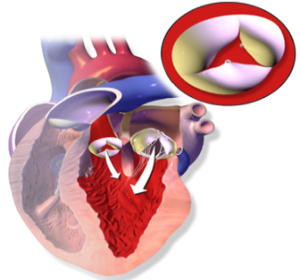Index
Bicuspid Aortic Valve

What Is Bicuspid Aortic Valve?
Bicuspid Aortic Valve (BAV) is an inherited form of heart disease in which two of the leaflets of the aortic
valve fuse during development in the womb resulting in a two-leaflet valve (bicuspid valve) instead of the normal three-leaflet valve (tricuspid).
BAV is the most common cause of heart disease present at birth and affects approximately 1.3% of adults. Normally, the mitral valve is the only bicuspid valve and this is situated between the heart's left atrium and left ventricle.
Heart valves play a crucial role in ensuring the unidirectional flow of blood from the atrium to the ventricles, or from the ventricle to the aorta or pulmonary trunk .
BAV is the most common cause of heart disease present at birth and affects approximately 1.3% of adults. Normally, the mitral valve is the only bicuspid valve and this is situated between the heart's left atrium and left ventricle.
Heart valves play a crucial role in ensuring the unidirectional flow of blood from the atrium to the ventricles, or from the ventricle to the aorta or pulmonary trunk .
What Causes Bicuspid Aortic Valve?
- Bicuspid aortic valve abnormality is seen in 1 to 2 percent of all live births.
- It is also the most observed cardiac defect in Turner syndrome.
- It is also the most observed cardiac defect in Turner syndrome.

What are the Signs & Symptoms of Bicuspid Aortic Valve?
In many cases, a bicuspid aortic valve will cause no problems.
People with BAV may become tired more easily than those with normal valvular function and have difficulty maintaining
stamina for cardio-intensive activities due to poor heart performance.
- Some Complications can be happening like for examples:
- Calcification
- Aortic lesions
- Aortic narrowing
- Some Complications can be happening like for examples:
- Calcification
- Aortic lesions
- Aortic narrowing
HEART CONDITIONS Diseases and Treated FAQ's
A bicuspid aortic valve can be associated with a heart murmur located at the right second intercostal space.
Often there will be differences in blood pressures between upper and lower extremities.
THE DIAGNOSIS CAN BE ASSISTED WITH:
- Echocardiography This is the most important test. It shows the movement of blood through the valve.
- Transesophageal Echocardiography This is a heart ultrasound done from the esophagus that can give better pictures of the aortic valve.
- Electrocardiogram This is done to check the heart’s electrical rhythm.
- Chest X-ray These help view the heart anatomy and lungs.
- Cardiac CT or MRI These are done if more detail is needed about the valve, heart, or aorta. Sometimes, bicuspid aortic valve first appears on an echocardiogram done for other reasons.
A Cardiologist might first diagnose it and made Classifications
- Bicuspid aortic valves may assume three different types of configuration:
- "Real" bicuspid valves with two symmetric leaflets.
- A tricuspid architecture with a fusion of two leaflets.
- A tricuspid architecture with a fusion of three leaflets.
THE DIAGNOSIS CAN BE ASSISTED WITH:
- Echocardiography This is the most important test. It shows the movement of blood through the valve.
- Transesophageal Echocardiography This is a heart ultrasound done from the esophagus that can give better pictures of the aortic valve.
- Electrocardiogram This is done to check the heart’s electrical rhythm.
- Chest X-ray These help view the heart anatomy and lungs.
- Cardiac CT or MRI These are done if more detail is needed about the valve, heart, or aorta. Sometimes, bicuspid aortic valve first appears on an echocardiogram done for other reasons.
A Cardiologist might first diagnose it and made Classifications
- Bicuspid aortic valves may assume three different types of configuration:
- "Real" bicuspid valves with two symmetric leaflets.
- A tricuspid architecture with a fusion of two leaflets.
- A tricuspid architecture with a fusion of three leaflets.
A bicuspid aortic valve may be repaired by reshaping the aortic valve leaflets allowing the valve to open and close more completely.
Bicuspid aortic valve repair can be performed using a minimally invasive “J” incision surgical technique.
Bicuspid aortic valve repair can be performed using a minimally invasive “J” incision surgical technique.